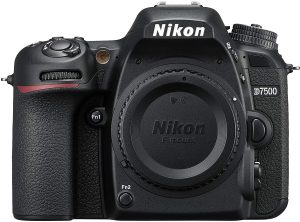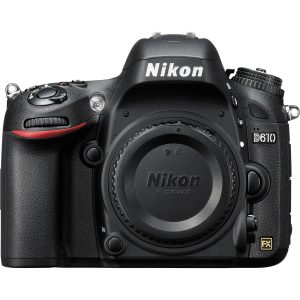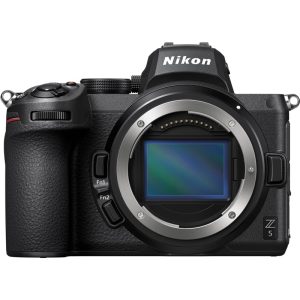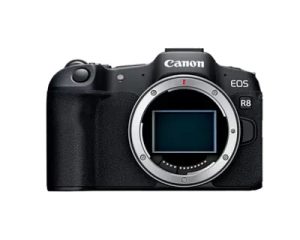
Shopping List Summary

- Digital Camera Body ( With removable lens and a shutter release port. 24MP or greater recommended)
- Lens ( A prime macro lens of the correct focal length to properly fill the frame with the desired film size within the distance range the scanner supports )
- Memory Card ( Minimum 16GB )
- Power Supply ( Unless you are OK recharging and cycling camera batteries )
- USB Cable ( MUST support data transfer. Allows for tethered capture or simplified file transfer. Camera may come with one. Most cameras are USB Micro or USB C, some are proprietary )
- Tethering Software ( Optional but recommended. Sony and Canon have free OEM options. Smart Shooter is our 3rd party recommendation. If you use Lightroom, it has tethering built in.
See below for a full breakdown of what to look for in a camera / lens.
Example Combinations
The following are examples of readily available lens / camera combinations across the range of common manufacturers and sensor formats.
This list is by no means exhaustive. There are countless camera models from the past few years that are incredibly capable imagers. If you are comfortable purchasing used equipment, KEH , MPB and B&H carry used options that are tested and graded. If you have any doubt about the compatibility of a certain camera / lens, don’t hesitate to reach out and ask.
Your selection may depend on availability, personal brand preference, total budget and wether you value certain features for use outside of scanning. For the vast majority of use-cases an entry level camera performs comparably to it’s higher spec’d counterpart. Many selling points of newer cameras ( NFC, GPS, high frame rate capture, Bluetooth, 4k video etc. ) are irrelevant for film scanning.
It is recommended to purchase a compatible AC power supply for uninterrupted scanning ( as opposed to cycling and charging batteries). Most but not all cameras support AC power supplies, typically in the form of a dummy battery.
Before purchasing via the (Amazon Affiliate ) links below, please first try to support your local independent camera retail store.
Nikon Full Frame Mirrorless (Z)
Lens: SlideSnap PRO + STRIP
- Nikon Z 105mm Macro
SlideSnap Strip : 35mm,126,APS,110.
SlideSnap Pro : The Z mount 105mm can only frame to 85% of a 35mm frame. Use the F mount 105mm with adapter if 100% crop is required. OR contact us for modification options.
( 62mm Filter thread. )
Nikon F-mount to Z-mount (FTZ) lens adapter broadens lens selection greatly to any of the F mount lenses listed below under Nikon Full-Frame.
SlideSnap STRIP
- Nikon Z 50mm Macro
SlideSnap Strip: 120,127. ( 35mm,126 APS and 110 after cropping )
( 46mm Filter thread )
Canon Full Frame Mirrorless (RF)
Lens: SlideSnap PRO + STRIP
An EF to RF adapter can be used with any of the lenses listed under Canon Full Frame (EF)
None of the three native RF macro lenses in the target focal length we are currently aware of are optimal choices due to physical constraints and lack of a 1:1 option.
The Canon RF 85mm macro only has a 1:2 ( 0.5x ) magnification.
The Canon RF 100mm with a 1.4x magnification, consequently is an inch too long to achieve full framing of a 35mm slide without modifying the projector.
The Venus Laowa 100mm RF , with a 2x magnification is physically longer still.
SlideSnap STRIP
( The Venus Laowa is an excellent manual focus lens )
Nikon APS-C (DX)
Camera Body

- Nikon D7500 (24MP / 4400PPI@35mm)
- Compatible Power Supply
- Shutter Release: N3
Alternates: D5200, D5300, D5500, D5600, D7100, D7200
Lens: SlideSnap PRO
SlideSnap STRIP
Nikon Full Frame (FX)
Camera Body

- Nikon D610 (24MP / 4400PPI@35mm)
- Compatible power supply
- Shutter Release Cable: N3
- Nikon D750 (24MP / 4400PPI@35mm)
- Compatible power supply
- Shutter Release: N3
Alternates: D800, D810 D600
Lens: SlideSnap PRO + STRIP
( 105mm will result in cropping of 120 on the Strip )
Canon APS-C (EF-S)
Camera Body
See ProductSee Product
See Product
- (4400PPI/24MP @35mm)
- Shutter Release: C1
Alternates: T6i, T7i
Lens: SlideSnap PRO
See Product See ProductSee Product
( Not wide enough for 127 / 120 on the Strip)
Budget Option : 172E Tamron 90 (JP Model)
SlideSnap STRIP
See ProductCanon Full Frame (EF)
Sony Full Frame Mirrorless (FE)
Camera Body
See ProductSee Product
- Sony A7 II (24.3MP / 4600PPI@35mm)
- Sony Multi Shutter Release Cable. ( SnapTether required. )
Lens: SlideSnap PRO + STRIP
See ProductSee Product
62mm Filter thread
(90mm Sony cannot fill frame with 35mm slides on the SlideSnap Pro, will require some cropping )
SlideSnap STRIP
See ProductSee Product
( Will need to crop down some for 35mm with the Sigma ) ( 49mm Filter thread)
Extras
Camera Requirements
The Essentials
- It should be a DSLR or mirrorless camera ( interchangeable lens ).
- Needs to have a hardwired shutter release port (so our equipment can trigger it).
- Support for USB tethering is not required but is strongly recommended. WiFi tethering is often unreliable.
- Support for constant power over USB, AC adapter or Dummy Battery Adapter is strongly recommended.
Resolution : 24MP seems to be the sweet spot for scanning 35mm images with higher resolutions subject to diminishing returns. Scan resolution in PPI / pixels per inch can be calculated by dividing your image width by your subject width. A 24MP image is 6000x4000px and a 35mm frame is 1.3″ wide. 6000/1.3 = 4615PPI. Assuming you overscan by 5%, you are looking at about 4400PPI after cropping.
Sensor Size : Full Frame vs Crop Sensor : In our testing, 35mm scans produced with a full frame sensor are qualitatively indistinguishable to those captured with a crop sensor. For medium format (120) scans, a full frame sensor can be worth the upgrade.
Sensor size WILL dictate the appropriate focal length of macro lens. A full frame sensor has 1.5x larger surface area and requires 1.5x the focal length to achieve the same framing as a crop sensor placed at the same distance. So where a 90mm lens is called on a full frame body, a crop sensor equivalent would be 60mm.
Mirrorless vs DSLR : Mirrorless is all the rage, primarily because it means a smaller package and fewer moving parts. It is a common misconception that mirrorless bodies have NO moving parts. They typically still have a mechanical shutter. One relevant advantage to mirrorless is that LiveView ( seeing what the camera sees on the LCD ) can be used full time without consequence to capture rate.
Lens options for the new mirrorless systems are comparatively limited, but growing.
Lens Requirements
- Lens Type : A Prime “Macro” lens with a 1:1 reproduction ratio. If it has an adjustable focal length (i.e 18-70mm) then it is not a prime, and likely not true macro. “Ultra” macro lenses with a magnification greater than 1x are often long-bodied, resulting in a shorter minimum working distance.
- Minimum Working Distance (MWD) : SlideSnap Strip > 69mm ; SlideSnap Pro > 137mm. If MWD is not listed, it can be calculated by subtracting the length of the lens ( fully extended length if lens has external focus ) and the Flange Focal Distance from the Minimum Focus Distance.
- Focal Length : (Generally speaking) : Crop Sensor ( SlideSnap Pro : 90mm, SlideSnap Strip : 60mm) Full frame ( SlideSnap Pro : 90-105mm, SlideSnap Strip: 90mm ).
- Autofocus : Entirely optional. Some prefer strictly manual focus. Can be nice to have the option for peace of mind. Adds 1-2s per scan.
- Lens Mount : Make sure it matches your camera body AND sensor format. For example, Nikon DX (crop-sensor) lenses will result in vignetting on an FX (full-frame) body. Older lenses might attach to but be feature limited on newer camera bodies.
- Focus Type (Internal vs External) : Internal is preferred. External means the front of the lens physically protrudes / extends to achieve close-focus. If you aren’t careful, it could run into the equipment.
- Vibration Reduction : Inconsequential as a selling point. We instruct you to disable it as it can have counterproductive effects when scanning.
Extension tubes, adapters etc.
Yes, you can experiment with adapters from one lens mount type to another., or turn a prime portrait lens into a macro lens using extensions tubes. You can achieve macro focus with add-on lenses or reverse mounting a portrait lens. You can shoot with a wider lens and aggressively crop ( at some loss of resolution ) instead of filling the frame with the image.
There are numerous alternative approaches available to you, but the added variables put these outside of the scope of our ability to consult. YMMV
Additional Notes
- Nikon Full Frame Mirrorless (Z) : New system. Two native macro lens options have been announced, a 105mm and a 50mm. Also, an F mount adapter is available for around $200.
- Canon APS-C Mirrorless (EF-M) : The M50 and M200 lack wired shutter release. Also no good native macro lens options at the time of writing.
- Sony APS-C Mirrorless (E) : Great cameras, but their diminutive size means attaching a substantial lens results in flexing at the tripod mounting point. Also, our SnapTether dongle will be required if you intend to USB tether.
- Nikon APS-C (DX) : The D3300 was the last of the 3000 series to support hardwire shutter release. The D3400 and D3500 only have (unsupported) infrared shutter release. 3000 series and 5000 series Nikon bodies can only autofocus AF-S lenses as they do not have a built in autofocus motor.
All of the product links on this page are affiliate links from which we receive a (small) commission if you use them.

